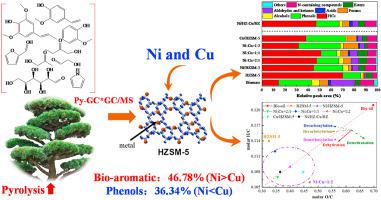Journal of the Energy Institute ( IF 5.6 ) Pub Date : 2021-04-20 , DOI: 10.1016/j.joei.2021.04.008 Yunwu Zheng , Jida Wang , Donghua Li , Can Liu , Yi Lu , Xu Lin , Zhifeng Zheng

|
To improve the quality of bio-oil and minimize coke formation, ex-situ catalytic biomass pyrolysis vapor upgrading to high-grade bio-aromatic and phenol compounds with Py-GC × GC/MS at different nickel-to-copper ratios was investigated. At the same time, the deoxygenation efficiency, structure-activity relationship, deactivation mechanism and possible pathways between combined mono- and bimetallic catalysts were also demonstrated. Ni and Cu species could be well dispersed, and the HZSM-5 support maintained the MFI crystal structure after bimetallic Ni–Cu modification, but the surface area, pore volume, and total acidity decreased. Bimetallic Ni–Cu catalysts showed better deoxygenation efficiency than monometallic catalysts, which had more advantages in the preparation of aliphatic hydrocarbons (29.86%) than mono- and bimetallic catalysts, which favored the production of aromatics (28.89%). Higher-Ni-loading catalysts promoted the formation of aliphatic hydrocarbons, aromatics and alkanes due to decarboxylation, decarbonylation and aromatization reactions, and higher-Cu-loading catalysts enhanced the olefin and phenol yields due to dehydration and demethylation reactions. Overall, the highest yields of bio-aromatic compounds and phenols were46.78% and 36.34%, respectively, at Ni-to-Cu ratios of 1:1 and 1:2, due to the high total acid amount and suitable average pore size for bio-aromatics and the low acidity and large pore size for phenols. The bimetallic Ni–Cu catalyst significantly increased the quality of bio-oil and reduced coke deposition.
中文翻译:

Ni-Cu双金属沸石催化剂对生物芳烃和生物酚转化生物质转化的活性和选择性
为了提高生物油的质量并最大程度地减少异地积炭研究了Py-GC×GC / MS在不同的镍铜比条件下催化生物质热解蒸气转化为高级生物芳烃和酚类化合物的过程。同时,还证明了脱氧效率,结构-活性关系,失活机理以及组合的单金属催化剂和双金属催化剂之间的可能途径。Ni和Cu物种可以很好地分散,HZSM-5载体在双金属Ni-Cu修饰后仍保持MFI晶体结构,但表面积,孔体积和总酸度降低。与单金属催化剂相比,双金属Ni-Cu催化剂的脱氧效率要高于单金属催化剂,后者在脂族烃的制备中具有29.86%的优势,而单金属和双金属催化剂则有利于芳烃的生产(28.89%)。高Ni负载的催化剂由于脱羧,脱羰基和芳构化反应而促进了脂肪烃,芳烃和烷烃的形成,而高Cu负载的催化剂由于脱水和脱甲基反应而提高了烯烃和苯酚的收率。总体而言,由于高的总酸量和合适的平均孔径,在镍与铜的比例为1:1和1:2的情况下,生物芳族化合物和酚的最高收率分别为46.78%和36.34%。生物芳香族化合物的酸度低,苯酚的酸度低且孔径大。Ni-Cu双金属催化剂显着提高了生物油的质量并减少了焦炭沉积。铜含量较高的催化剂由于脱水和脱甲基反应而提高了烯烃和苯酚的收率。总体而言,由于高的总酸量和合适的平均孔径,在镍与铜的比例为1:1和1:2的情况下,生物芳族化合物和酚的最高收率分别为46.78%和36.34%。生物芳香族化合物的酸度低,苯酚的酸度低且孔径大。Ni-Cu双金属催化剂显着提高了生物油的质量并减少了焦炭沉积。铜含量较高的催化剂由于脱水和脱甲基反应而提高了烯烃和苯酚的收率。总体而言,由于高的总酸量和合适的平均孔径,在镍与铜的比例为1:1和1:2的情况下,生物芳族化合物和酚的最高收率分别为46.78%和36.34%。生物芳香族化合物的酸度低,苯酚的酸度低且孔径大。Ni-Cu双金属催化剂显着提高了生物油的质量并减少了焦炭沉积。











































 京公网安备 11010802027423号
京公网安备 11010802027423号